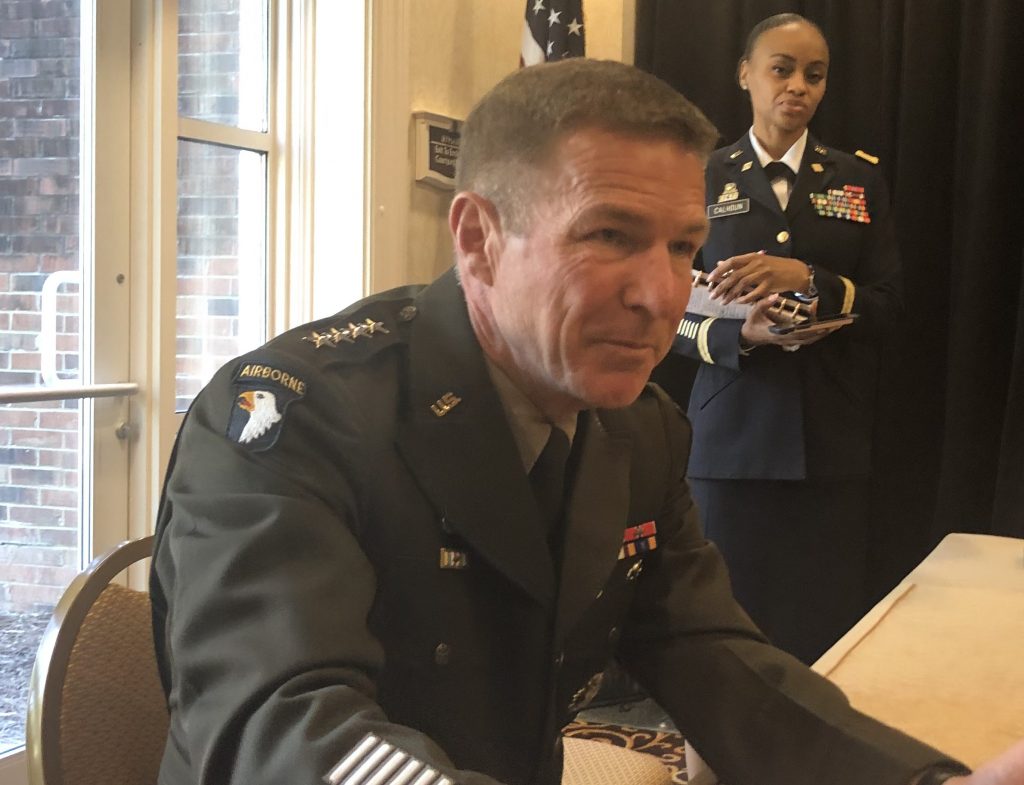
Gen. James McConville
WASHINGTON: The Army Chief of Staff wants more soldiers but the service can’t afford them, and he publicly accepts that. The Army can accept an end to endstrength growth and will economize on training to boost its modernization program, Gen. James McConville said Thursday.
McConville has consistently rejected the idea of steep cuts to end-strength, readiness or modernization. Will his proposed sacrifices be enough to stave off steep budget-cuts?
“We’ve got some really good programs going,” McConville told a Brookings webcast. “We probably need about two or three more years of good solid budgets.”
While McConville didn’t specify why “two or three… years,” depending on when you start counting, that would take the Army through 2023 That’s when a first wave of weapons prototypes are set to enter testing and key contracts will be awarded for others. Once hardware starts coming off a production line, it’s much easier to show lawmakers it really works – and that it really creates jobs. So the Army may be betting it just needs to survive the next couple years and get high-tech hardware like hypersonics into tangible form to secure long-term funding for modernization after 2023.
“We don’t want bridges to nowhere,” McConville said, no doubt thinking of Future Combat Systems and the many other cancelled Army programs of the past. “To me, success… is, whatever weapon system we develop, it’s in the hands of soldiers and it makes a difference…. What I’ve seen so far is Congress is supportive if we can make the argument, and we can show that we are developing and fielding our programs to the most efficient and effective way, and they support … the Joint Warfighting Concept.” [That is, instead of the Army spending on priorities out of synch with the Joint Staff’s – ed.]
The problem is that the Army’s argument in the ongoing budget debate appears to be, in essence, ‘we gave at the office.’ The service has already cut hundreds of programs to free billions for new weapons, officials have been saying, and it’s accepted minimal growth in endstrength – isn’t that enough? Given the tremendous pressure on the defense budget in the face of the $5 trillion that may be spent on COVID relief and domestic infrastructure, on top of the tremendous pressure on the Army from sea and air power advocates, the answer is probably, ‘no – you’re going to get cut more.’”
Of course, McConville would be a poor negotiator if he publicly accepted steep cuts at this early stage, when the Biden Administration is struggling to finalize the 2022 budget request, which is likely to be flat, let alone 2023, when it will have more leeway to make cuts. He was candid about the pressure he and his fellow military leaders are under.
“Everyone is taking a hard look at how much money we’re spending [because] we’re in a competition for resources,” McConville said. “Everyone’s trying to figure out how we get the security we need for the country in the most efficient and effective way.”
So what is McConville willing to give up, publicly, at this point?
“First of all, you don’t buy more structure and people than you absolutely need, because that’s where the expense is,” he said.
“I’ve already, probably, had to give up the growth that we [had] planned in the Army, because we do go flatline” in the overall budget, McConville continued. “We’ve already kind of made that decision.”
“I would have a bigger army…. if I thought we could afford it. I think we need it,” he said, noting the current force is almost the same size it was on 9/11 and far short of the peak required for the Iraq War.
But giving up endstrength growth – which had dwindled to a few thousand soldiers a year – is not a big sacrifice. What about readiness?
“There’s some things we can do to make our training more efficient and more effective,” McConville said, hinting that overseas exercises could be cut back: “Maybe you don’t do as exotic type exercises; you might be able to get the same type of training at the CTC,” he said, referring to the Army’s Combat Training Centers in California, Louisiana and Germany. “You may not rotate the forces much overseas. You might look at using our pre-positioned stocks more forward rather than actually bringing the whole system over there” – i.e., deploy the personnel overseas for training but leave behind their equipment, instead picking up materiel already warehoused abroad.
Again, those aren’t big sacrifices for the Army to make – but they would require careful handling not to offend foreign partners and allies.
Sullivan says Ukraine supplemental should cover all of 2024, long-range ATACMS now in Ukraine
“We now have a significant number of ATACMS coming off their production line and entering US stocks,” Jake Sullivan said today. “And as a result, we can move forward with providing the ATACMS while also sustaining the readiness of the US armed forces.”


























